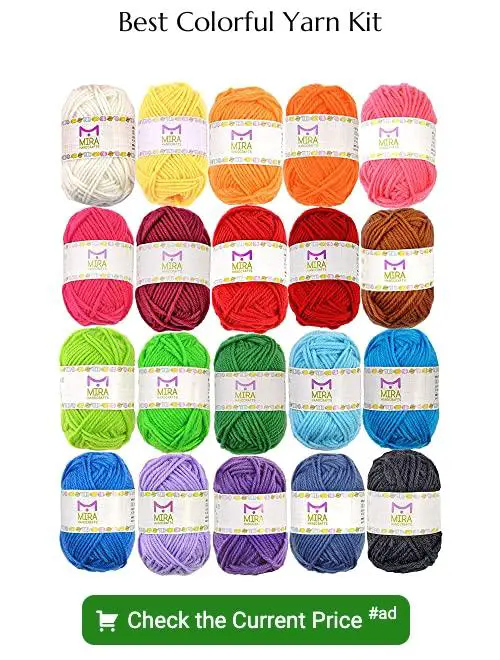Discover the allure of rainbow yarn because its vibrant hues can transform your yarn craft projects from simple to simply stunning.
Rainbow yarn, with its vibrant spectrum of hues, is an impeccable choice for any yarn craft. Whether you’re delving into crocheting or exploring knitting, a colorful piece made from this yarn is sure to turn heads and warm hearts.
This article will take you through the types of rainbow yarn, the unique characteristics that define them, and the best ways to showcase their striking colors in your projects.
Let’s cast on and begin the journey into the beautiful world of rainbow yarn. Immerse yourself in the confidence that all your questions about rainbow yarn will find satisfying answers here.
Key takeaways:
- Rainbow yarn incorporates all the hues of a rainbow.
- Types of rainbow yarn include acrylic, wool blend, pastel, hand-dyed, and gradient.
- Consider the project, color transition, yarn feel, and care instructions when choosing rainbow yarn.
- Proper yarn care includes following washing instructions and storing away from direct sunlight.
- Crochet patterns like C2C and granny squares, and simple knitting patterns work well with rainbow yarn.
Understanding Rainbow Yarn

Rainbow yarn, as the name suggests, incorporates all the vibrant hues of a rainbow. It’s often categorized under multicolor or variegated yarns, but the distinct characteristic here is its colorful sequence akin to a rainbow – red, orange, yellow, green, blue, indigo, and violet – repeated throughout the length of the yarn.
These vibrant colors are skillfully dyed into the fiber where the changes between hues can be sudden or gradual, depending on the dyeing technique used. Look at the specification of the yarn to understand the length of each color run and the transition style.
When utilized in a project, rainbow yarn can create magnificent color play, resulting in uniquely patterned knitwear or crocheted items. Variations can occur from one skein to another due to the hand dyeing process.
Remember: the pattern or structure of the stitch, the thickness of the yarn, and the dimension of the project can all greatly influence how the rainbow coloring manifests in the finished piece.
Types of Rainbow Yarn
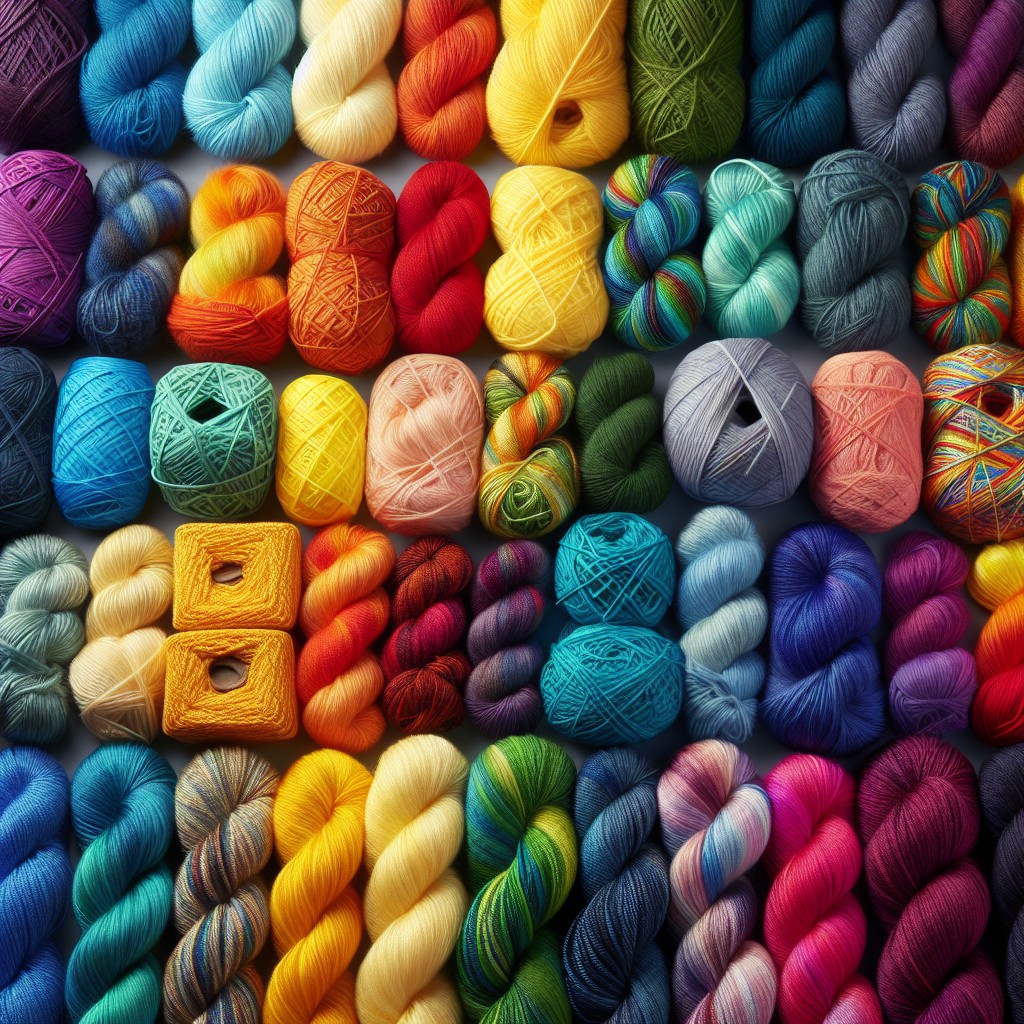
There are several popular types of rainbow yarn available on the market. Many yarn manufacturers offer rainbow-colored options, available in a variety of fiber contents and weights.
For a classic look, consider using an acrylic or wool blend featuring a bold, repeating pattern of rainbow colors. This type is versatile and suitable for various projects, from scarves to blankets.
If you’re interested in a more subtle appearance, a pastel rainbow yarn might be what you’re looking for. This type typically uses more muted, light hues, perfect for baby clothes or delicate decor items.
Meanwhile, for those seeking an upscale, unique selection, you may want to explore hand-dyed rainbow yarn options. Hand-dyed yarns often have variations and slight imperfections that add depth and personality to your projects.
Finally, you might want to consider rainbow yarn with gradient changes, where one color gently tapers into the next, for a beautiful ombre effect. Ideal for shawls and garments, gradient yarns create stunning, seamless transitions on a larger scale.
As a general tip, always make sure to check the yarn’s weight and fiber content to ensure it is suitable for your intended project before purchasing.
How to Choose Rainbow Yarn
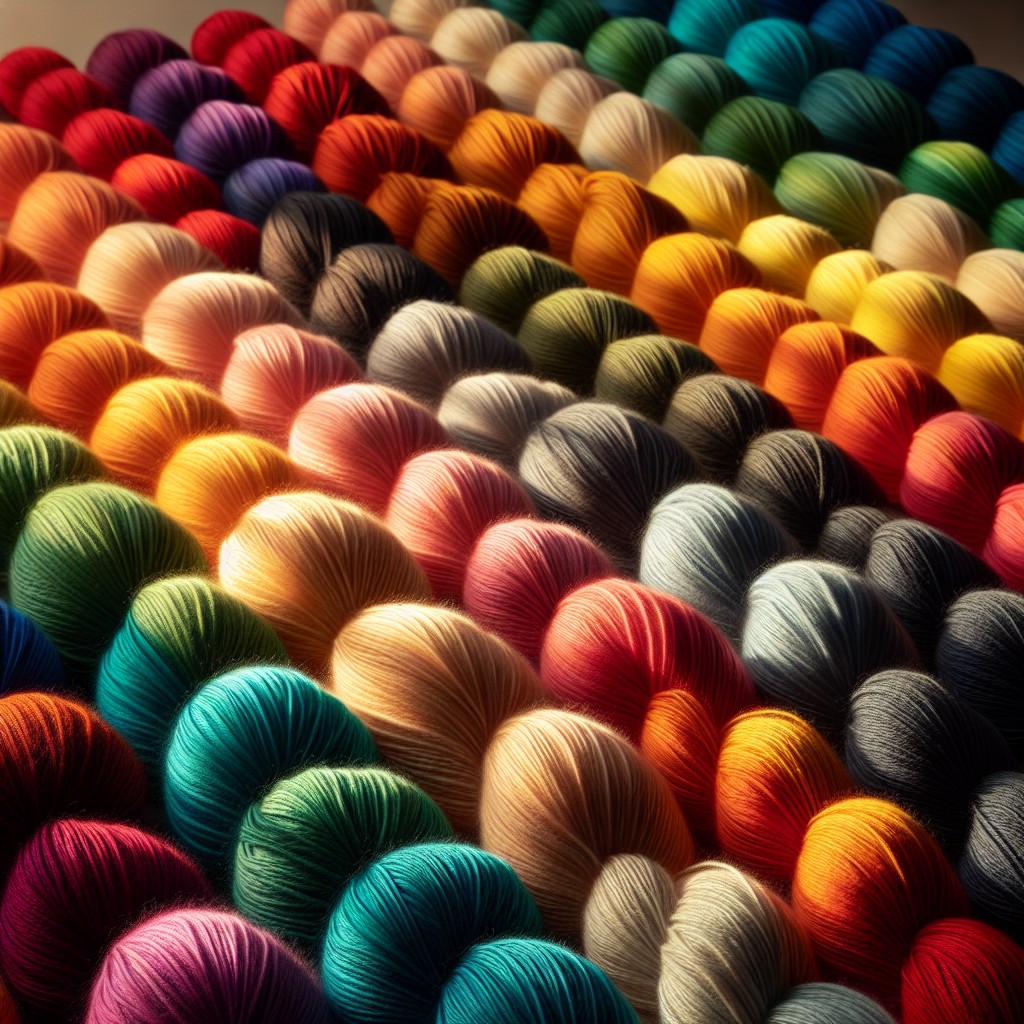
Consider the project you’re planning. Sweaters or blankets may require durable, heavy-weight yarn while scarves or baby clothes may be better suited to a softer, lighter option.
Secondly, examine the color transition in the yarn. Some rainbow yarns have sharp, distinct color changes, while others have a more subtle, gradual shift.
Then, touch the yarn. It should feel comfortable in your hands, as rough or scratchy yarn could make the crafting process uncomfortable.
Finally, look at the yarn’s care instructions. Consider if it matches with your or the intended user’s lifestyle, for example, some yarns may require hand-washing or a special type of detergent.
These factors, when taken into account, will ensure you select the ideal rainbow yarn for your next project.
Yarn Care for Rainbow Yarn
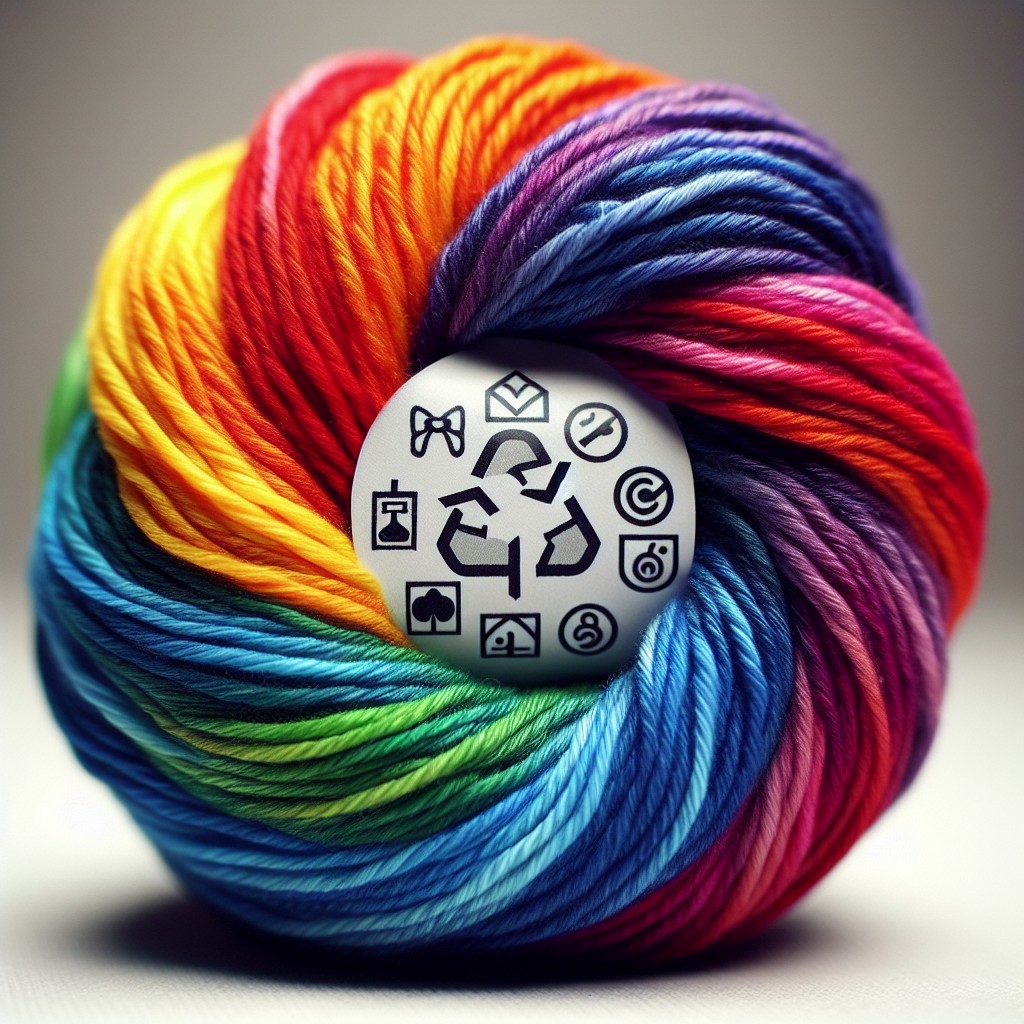
To ensure the vibrant hues of your rainbow yarn stay as dazzling as the day you bought it, proper yarn care is essential.
Firstly, always check the label on the yarn. The label contains valuable information about washing and drying procedures. Some yarns might be machine washable, while others might require a more delicate hand-washing routine.
Avoid using bleach or strong detergents, as these can damage the fibers and fade the colors. Instead, opt for a gentle, color-safe laundry detergent.
For drying, aim to air-dry your yarn crafted items flat to help them retain their shape. Machine drying isn’t usually recommended since the heat can cause shrinkage or even lead to the colors bleeding.
Finally, when not in use, keep your rainbow yarn stored away from direct sunlight to prevent color fading. A cool, dry place is perfect for storing your yarn. This way, the dazzling colors of the rainbow yarn will remain vibrant and beautiful for your future projects.
How to Store Rainbow Yarn
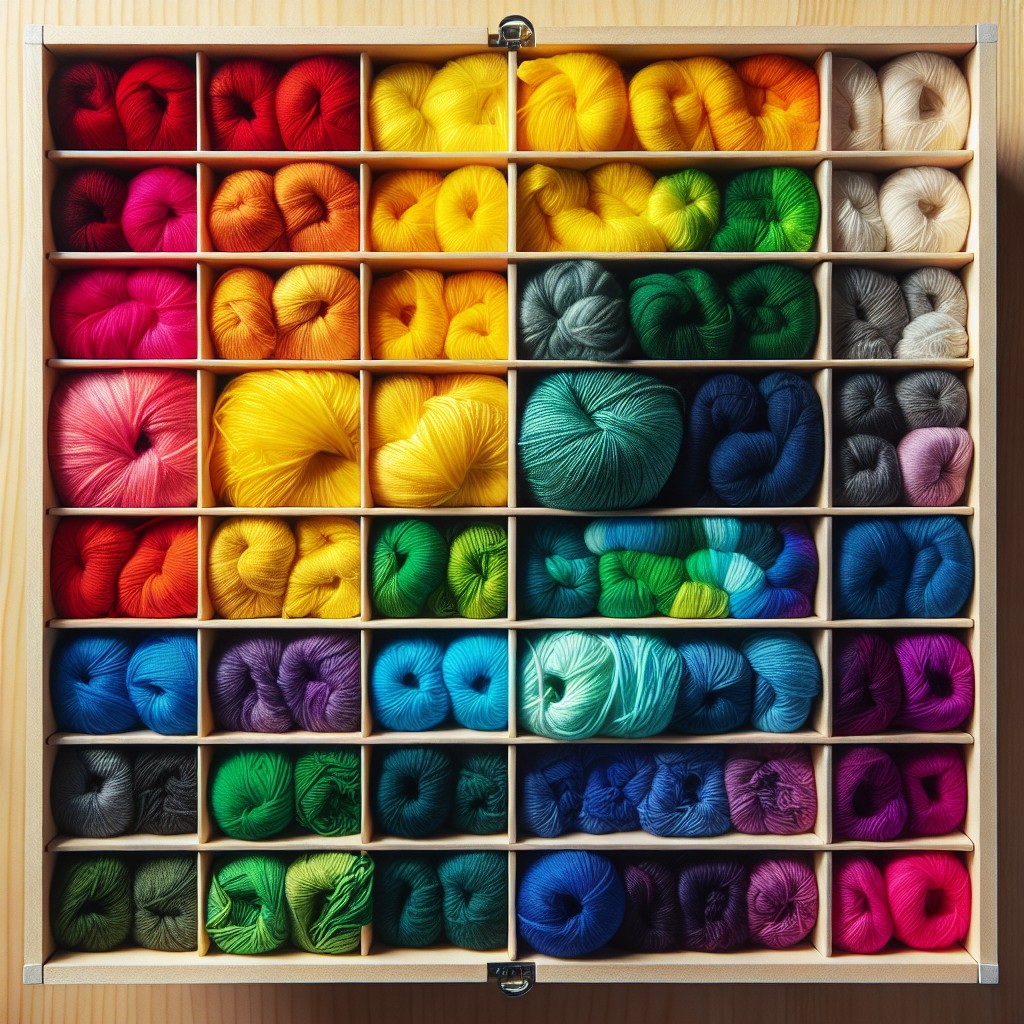
Proper storage is a key aspect of maintaining the vibrancy and quality of your rainbow yarn. Begin with a clean, dry place as moisture can lead to mold and mildew, damaging the yarn. Opt for clear, zippered plastic bags or bins for storage to prevent insects from getting in without obscuring visibility.
For those with a big stash, consider categorizing your yarn by color or yarn weight to make it easier to find specific skeins later.
Avoid storing yarn in direct sunlight as it can bleach colors and degrade the fiber over time. It’s also helpful to loosely loop leftover yarn into hanks, rather than balls or skeins, which can keep the tension consistent and prevent stretching.
Regularly check on stored yarn for any signs of dampness, insects or other potential damage. Implement these measures and your rainbow yarn will stay bright, vibrant, and clean for your next project.
Crocheting With Rainbow Yarn
When venturing into projects with rainbow yarn, consider selecting crochet patterns that highlight the unique color transition. Corner-to-corner (C2C) crochet and granny squares are particularly suitable.
1. C2C Method: This method allows for a diagonal color change, enhancing the beauty of the rainbow gradient. Crocheting small squares or rectangles before joining them produces impressive results.
2. Granny Squares: Perfect for beginners, these classic patterns allow for distinct color transitions by alternating rows with different sections of the rainbow yarn.
Keep in mind that simpler stitches often work best to allow the multi-color yarn to shine. Elaborate stitches might become muddled and lose their definition amidst the dazzling spectrum of colors.
To make the most of the rainbow effect, use longer stitches like trebles instead of shorter stitches like doubles. This brings out each color transition effectively, making your piece vibrant and eye-catching.
Remember, crocheting with rainbow yarn is a fun creative journey. There’s lots to experiment with, from stitch choice to pattern selection, so enjoy the ride and revel in the splash of colors!
Knitting With Rainbow Yarn
Mastering the art of knitting with rainbow yarn can significantly enhance the final results of your projects. Here are a few aspects that may help:
1. Gauge Swatch: Before you dive in, always knit a small square to check your stitch and row gauge. Changes in color can sometimes affect your tension.
2. Choosing Patterns: Opt for simple, visually striking patterns, like stripes or solid blocks of color. Intricate patterns may get lost in the color transitions.
3. Attention to Color Changes: When starting a new skein, it’s important to pay attention to where the color transition starts and ends. Aligning the colors correctly ensures a smooth, continuous gradient.
4. Dealing with Knots: Rainbow yarn is often dyed in sections, and sometimes knots can occur between color changes. If you encounter a knot, cut the yarn and start a new color section to maintain the color sequence.
5. Using Circular Needles: For larger projects, circular needles can make handling the automatically changing colors much easier and comfortable.
Projects for Rainbow Yarn
Just like a real rainbow, rainbow yarn brings enjoyment and fascination with its vibrant colors. It’s a delightful choice to make your yarn crafts pop and it can be used in various projects.
1. Scarves: With a basic garter stitch, a rainbow yarn scarf is perfect for beginners. The popping colors make the knitting or crochet process enjoyable. Plus, it looks amazing when finished!
2. Blankets: Light, medium, or chunky rainbow yarn all work great for blankets. The swirl of the colors can create eye-catching patterns. Consider granny squares or ripple patterns for a unique effect.
3. Hats: Add a splash of color to colder months with rainbow hats. Beanie, slouchy, or infinity — any hat style works wonderfully with rainbow yarn.
4. Amigurumi: Creating cute and colorful stuffed creations are fun with rainbow yarns. They make a cheerful addition for kids’ playtimes.
5. Baby projects: Baby items such as bibs, booties, and cuddly toys can all be made more lively and appealing with rainbow-colored yarn.
These are just a start! With the versatile rainbow yarn, your creative possibilities are limitless. Happy creating!
Patterns for Rainbow Yarn
When choosing patterns, observe designs that show off the beautiful colors in rainbow yarn. Variations can be enjoyed with different stitches and simple patterns, which allow the yarn’s hues to pop. For instance, a chunky knit scarf or an amigurumi toy can be made stunning using rainbow yarn.
For crochet enthusiasts, a granny square or a ripple stitch blanket utilizes the color changes impressively. On the other hand, knitters can opt for a feather and fan or a slipped stitch mosaic pattern to intensify colors. When employing intricate patterns or colorwork, be cautious as they might compete with your yarn’s rainbow effect.
Remember, the key in crafting with rainbow yarn is to keep design elements simple and allow the yarn’s spectrum to shine. Patterns should compliment your yarn, not compete with it. Experiment with different styles and stitches to find what works best for your rainbow yarn project.
Mistakes to Avoid When Working With Rainbow Yarn
Refrain from using a small stitch pattern. Complex or smaller designs can diminish the impact of the vivid color scheme. Instead, allow the rainbow hues to take the lead by opting for simpler stitches.
Avoid mixing with other overly bright or patterned yarns. The vibrant colors in rainbow yarn are best appreciated when not competing for attention.
Take care not to cut your yarn in the middle of a color change, as this can disrupt the gradient flow of hues in your pattern.
Beware of using the wrong weight or type of yarn for your intended project. A mismatch can lead to issues with both the finished look and the durability of the item. Make sure to always double-check the yarn variant before starting.
Be mindful of the yarn tension. Too tight or too loose stitches can affect how the colors transition, potentially detracting from the visual appeal of the finished piece.
Lastly, care for your yarn. Rainbow yarn, while durable, still requires proper care to maintain its vibrancy and prevent any color fading. Always follow the specific washing and care instructions provided for your chosen yarn.
Recommended Rainbow Yarn Products
A popular choice for vibrant crafting, Schachenmayr Catania Color is a 100% cotton yarn well-loved by many for its color variety and smooth texture. Their range boasts numerous rainbow options.
Lion Brand’s Mandala yarn is an excellent acrylic option with gradual color transitions. Perfect for large projects, it’s designed to create unique, creative colorways as you craft.
The Rainbow Rolls by Purl Soho provide an exciting unspun, gently felted wool option. These come in multicolor options that give your work a unique, painterly effect.
A high-end favorite, the Noro Kureyon Yarn, promises luxury with its wool and silk blend. Known for its long, striking color repeats, each skein provides a different crafting experience.
Premier Yarns’ Sweet Roll combines complementing colorways in each ball, making it easy to achieve a colorful gradient effect without manually changing threads.
YarnArt Flowers is a lightweight cotton-acrylic blend perfect for summer projects. Its meticulously arranged colors create a bouquet-like effect when worked into a pattern.
Remember to check the product’s weight and fiber content to ensure they’re suitable for your project. It’s also important to factor in the project type and size before making a purchase.
Hand Dyed Rainbow Yarn
For a more personalized touch to your crafts, you may want to give hand-dyed rainbow yarn a try. This technique offers a few serviceable benefits:
- Uniqueness: No two skeins of hand-dyed rainbow yarn are exactly alike because the dyes are applied by hand rather than by a machine. This leads to individualistic patterns, even within the same dye lot.
- Color Range: Hand-dyeing allows for a greater range and depth of color. It is possible to achieve subtle hues or more intense, vibrant tones, depending on the technique used. The artist assumes control over color placement, creating non-repeatable effects.
- Supporting Small Businesses: Many hand-dyed yarns come from independent artists and small businesses, which can be a rewarding way to support craft culture.
While it might appear more expensive than mass produced counterparts, remember that crafting with hand-dyed rainbow yarn you are creating a one-of-a-kind piece.
Creating Color Gradient With Rainbow Yarn
Utilizing the natural progression of colors in your rainbow yarn, you can create a stunning gradient effect in your projects. Here are some tips to make a smooth gradient:
1. Start with choosing your yarn. The beauty of rainbow yarn is that it already has multiple colors woven together, saving you from having to switch colors manually.
2. As you begin to work on your project, pay extra attention to the color sequence in your yarn. Following this sequence ensures an organic color transition.
3. Where possible, aim to start and end rows on a color change. This will make for a more visually pleasing gradient.
4. Should you find breaks in the color sequence, due to knots or joins, take time to untangle and realign the colors. This might involve cutting and rejoining the yarn to maintain color order.
5. If you’re working on a larger project, remember to check that sequential skeins match in color gradient. Achieving a consistent gradient depends on continuity from one skein to the next.
Remember, practice is key to mastering the use of rainbow yarn and achieving the gradient look you desire. Happy crafting!
Choosing the Right Tools for Rainbow Yarn
When working with rainbow yarn, it’s critical to pick the correct tools. The choice solely depends on the weight and fiber content of your yarn, as well as the pattern you will be following. For example, lightweight yarns work best with smaller hook and needle sizes to ensure a tight, cohesive fabric, while heavier yarns require larger hooks or needles.
It’s noteworthy that natural fibers such as wool or cotton might slide easier on wooden or bamboo needles, while synthetic yarns might prefer metal tools. Furthermore, circular needles might be a good choice when knitting large projects, such as blankets, as they can accommodate numerous stitches.
Always remember to check your pattern’s recommendation, as well as the yarn’s label instructions. And most importantly, don’t shy away from making a small gauge swatch. It can serve as a handy guide in determining whether your selected tools and yarn match perfectly, ensuring a successful outcome to your rainbow yarn project.
Highlighting Brands: Hobbii Rainbow Yarn
Hobbii’s Rainbow Yarn stands out as a favorite among both crocheters and knitters thanks to its softness and durability.
Crafted in 100% cotton, this yarn sports long-color sequences that create unique visual effects in your craft projects.
The yarn weight is categorized as light (3), making it ideal for creating garments and accessories that are both lightweight and breathable.
Notably, Hobbii offers Rainbow Yarn in a variety of colorways beyond the typical spectrum, including pastels and earth tones.
This broadens the possible aesthetics and moods created in projects.
Also, the fact that it’s OEKO-TEX certified ensures it’s free from harmful substances.
Consequently, it’s not only safe for skin contact but also an appealing choice for eco-conscious crafters.
Keep in mind the recommended needle or hook size for optimal stitch definition is 4-5 mm depending on your tension.
Lastly, taking care of finished projects is straightforward as Hobbii Rainbow yarn is machine washable at 40 degrees Celsius, simplifying your post-project maintenance tasks.
Highlighting Brands: Patons Linen Rainbow Yarn
Patons Linen is known for its ever-lively color range. The suggested rainbow yarn from Patons, encompassing the calm and subtle to the bold and bright in the spectrum, is a highly versatile choice due to its blend of linen and acrylic fibers. This composition makes it a durable option, resistant to moth and mildew, ideal for many knitting and crochet projects that need both structure and drape.
The thickness of the Patons Linen Rainbow Yarn falls in the medium weight category, making it perfect for beginners and seasoned crafters alike. The medium weight allows for easy handling and noticeable texture in finished projects, offering a satisfying feel in hand.
One of the unique properties of this yarn is its ability to achieve a polished “worn-in” look over time due to the linen component. This attribute provides a special, vintage charm to works crafted with the Patons Linen Rainbow Yarn, adding a unique twist to the colorful creations.
When it comes to washing and care, this yarn allows for machine wash, which can be highly advantageous for daily wear items. However, make sure to read and follow the washing instructions carefully to maintain both the color vibrancy and structural integrity of the yarn.
Lastly, while planning projects, keep in mind that each skein of Patons Linen Rainbow Yarn typically contains about 137 yards (125 meters) of yarn. Always calculate the quantity needed beforehand to ensure you have enough for your whole project without troubling interruptions. This bit of planning aids in achieving a uniform color pattern, especially important with rainbow yarn.
Yarn Information: Understanding Weight and Fiber Content
To gauge the right yarn for your project, it’s crucial to comprehend two key factors – weight and fiber content.
Weight refers to the thickness of the yarn strand. Lighter weights like lace or fingering are perfect for delicate, fine projects, while heavier weights like chunky or bulky work well for warm, cozy crafts. Rainbow yarn is available in various weights to suit a wide array of projects.
On the other hand, fiber content indicates what the yarn is made from. This could be natural fibers like cotton, wool, alpaca, or man-made fibers like acrylic or polyester. The fiber content can drastically influence the texture, appearance, and usability of the yarn. For example, wool tends to be warm and hypoallergenic, whereas cotton is cool and washable. Synthetic fibers are often more durable and cheaper.
When selecting rainbow yarn, consider both the weight and fiber content to ensure it aligns with your project requirements and personal style.
Creating Texture With Rainbow Yarn
The manipulation of stitches in your knit or crochet work can bring out the eye-catching colors of rainbow yarn, offering varying depths, highs and lows of texture.
Follow these pointers to enhance texture using rainbow yarn:
- Mix Stitches: Switch between basic and complicated stitches. A beautiful contrast can be achieved between the simplicity of a single crochet and the more ornate shell stitch.
- Tweaking Tension: Altering your tension allows for different texture effects. Looser stitches can provide a drape, while tighter ones offer solidity to the project.
- Pair with Solids: When combined with solid colors, rainbow yarn can pop even more, accentuating the texture differences.
- Try Different Hook or Needle Sizes: Larger hooks or needles can create a looser fabric with more drape, while smaller ones produce a tighter, more structured fabric.
Being mindful of these strategies while working with rainbow yarn will allow you to effectively create an array of textural interest in your project.
Reusing and Repurposing Leftover Rainbow Yarn
After the completion of a glorious multicolored project, some strands may invariably remain. These tangles of color hold immense potential if applied creatively.
1. Utilize in Small Projects: Even short pieces can be used for small-scale crafts such as bookmarks, tassels, or jewelry.
2. Combine with Other Yarns: Merge leftovers with other shades or textures to generate a new visual effect. This especially works for items like afghans or scarves, radiating an appealing boho vibe.
3. Yarn Scraps as Filling: Use these snippets as stuffing in cuddly toys or cushions. They work excellently, and it’s always a delight thinking of the concealed spectrum within.
4. Craft Embellishments: Making fringe or pom-poms for hats, wraps, or throws lend a vibrant touch.
5. Create Art: Wrap around cardboard shapes or letter templates for unique, yarn-themed decor pieces.
Remember, the leftover rainbow yarn is alight with potential, urging you to think creatively. Turn the so-called scraps into treasures, one strand of joyous color at a time!
The Environmental Impact of Rainbow Yarn
Yarn production often involves numerous chemical dyes, which can seep into the environment during the processes, raising significant environmental concerns. However, several yarn manufacturers have adopted sustainable practices to counter this.
Consider ethical yarn brands that utilize natural dyes or more environmentally-friendly synthetic dyes in their production. Several of these manufacturers also prioritize the use of organic cotton, recycled materials, or renewable fibers like bamboo or hemp.
Always remember to recycle or repurpose your yarn scraps. Simply tossing leftover yarn can contribute to landfill clutter. Instead, transform yarn trash into crafting treasure. Tiny scraps can become stuffing for amigurumi or sewn into a unique ‘frankenyarn.’
Lastly, find ways to give unused yarn a new life. If you have balls of rainbow yarn you don’t plan to use, consider donating them to local schools, community centers, or retirement homes where they can be used in art projects or by other crafters.
Being mindful of these points when purchasing and using rainbow yarn can significantly decrease its environmental impact.
FAQ
What is rainbow yarn?
Rainbow yarn is a worsted type of yarn, frequently found in the industry, that is fabricated by blending acrylic with nylon, notable for its vibrant colors and smooth finish.
What weight is rainbow cotton yarn?
Rainbow cotton yarn is available in two weights, an 8 ply DK weight and a 4 ply fingering weight.
What is multi colored yarn called?
Multi-colored yarn is known as variegated yarn.
How is rainbow yarn created during the dyeing process?
Rainbow yarn is created by applying different colored dyes to separate sections of the yarn during the dyeing process.
What kind of projects can be best suited for rainbow cotton yarn?
Rainbow cotton yarn is best suited for projects like dishcloths, baby blankets, amigurumi toys, and colorful summer tops.
What are the different techniques one can employ to crochet or knit with multi-colored yarn?
One can crochet or knit with multi-colored yarn using various techniques such as striping, fair isle (stranded knitting), intarsia, slip stitch colorwork, mosaic knitting, and tapestry crochet.
